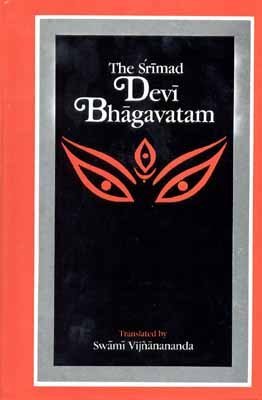The Devi Bhagavata Purana
by Swami Vijñanananda | 1921 | 545,801 words | ISBN-10: 8121505917 | ISBN-13: 9788121505918
The English translation of the Devi Bhagavata Purana. This Sanskrit work describes the Devi (Divine), the Goddess, as the foundation of the world and as identical with Brahman, the Supreme Being. The Devi Bhagavata Purana is one of the most important works in Shaktism, a branch of Hinduism focusing on the veneration of the divine feminine, along w...
Chapter 19 - On the midday Sandhyā
1-24. Nārāyaṇa said :-- O Nārada! Now I am speaking of the auspicious midday Sandhyā, the practice of which leads to the wonderfully excellent results. Listen. Here the Ācamana and other things are similar to those of the morning Sandhyā. Only in meditation (Dhyānam) there is some difference. I will now speak of that. The name of the midday Gāyatrī is Sāvitrī. She is ever a youthful maiden, of white colour, three-eyed; She holds in Her one hand a rosary, in Her other hand a trident and with Her two other hands She makes signs to Her Bhaktas to dispel fear and to grant boons. Riding on the bull, She recites the Yayur Vedas; She is the Rudra Śakti with Tāmo guṇas and She resides in Brahmaloka, She daily traverses in the path of the Sun. She is Māyā Devī, beginningless; I bow down to Her. After meditating on the Ādyā Devī Bhagavatī perform Ācamanas and other things as in the morning Sandhyā. Now, about the offering of Arghya (an offer of green grass, rice, etc., made in worshipping a God or Brāhmaṇ). Collect flowers for Arghya; in the absence of flowers, the Bael leaves and water will serve the purpose. Facing the Sun, and looking upwards, offer the Arghya to the Sun upwards. Then perform other acts as in the morning Sandhyā. In midday, some offer Arghya to the Sun, only with the recitation of the Gāyatrī mantra. But that is not approved of by the tradition and community; there is the likelihood of the whole work being thwarted or rendered fruitless. For, in the morning and evening Sandhyās, the Rākṣashas named the Mandehās become
ready to devour the Sun. This is stated in the Śrutis. Therefore the midday offering of the Arghya is not for the destruction of the Daityas but for the satisfaction of the Devī; so with the mantra “Ākṛṣṇena, etc.,” the offering of Arghya can be effected; and the reciting of the infallible Gāyatrī mantra is only to create disturbance in the shape of thwarting the action. So in the morning and evening, the Brāhmaṇa is to offer the Sūryārghya, repeating the Gāyatrī and Praṇava; and in the midday to offer flowers and water with the mantra “Ākṛṣṇena, rajasā etc.,” else it will go against the Śruti. In the absence of flowers, the Durba grass, etc., can be offered carefully as the Arghya; and the full fruits of the Sandhyā
will be secured. O Best of Devarṣis! Now hear the important points in the Tarpaṇam (peace offerings).
Thus :--
“Om Bhuvaḥ puruṣam tarpayāmi namo namaḥ.”
“Om Yajurvedam tarpayāmi namo namaḥ.”
“Om Maṇḍalam tarpayāmi namo namaḥ.”
“Om Hiraṇyagarbham tarpayāmi namo namaḥ.”
“Om antarātmānam tarpayāmi namo namaḥ.”
“Om Sāvitrīm tarpayāmi namo namaḥ.”
“Om Devamātaram tarpayāmi namo namaḥ.”
“Om Sāmkritim tarpayāmi namo namaḥ.”
“Om Yuvatīm sandhyām tarpayāmi namo namaḥ.”
“Om Rudrāṇīm tarpayāmi namo namaḥ.”
“Om Nīmrijām tarpayāmi namo namaḥ.”
“Om Bhurbhuvaḥ Svaḥ puruṣam tarpayāmi namo namaḥ.”
Thus finish the midday Sandhyā mga Tarpaṇam.
Now, with your hands raised high up towards the Sun, worship Him by the two mantras, praising thus :-- “Om Udutyam Jātavedasam, etc.,” “Om Citram Devānām, etc.” Next repeat the Gāyatrī. Hear its method. In the morning, repeat the Gāyatri at the proper moment with hands raised; in the evening time with hands lowered and in the midday with hands over the breast. Begin with the middle phalanx (joint) of the nameless finger, then the phalanx at its root, then the phalanx at the root of the little finger, its middle phalanx and its top, then the tops of the nameless, fore and ring fingers, then the middle and finally the root of the ring finger (in the direction of the hands of the watch; avoiding the middle and root phalanx of the middle finger). Thus ten times it is repeated. In this way if the Gāyatrī be repeated one thousand times, the sins arising from killing a cow, father, mother, from causing abortions, going to the wife of one’s Guru, stealing a Brāhmaṇa’s property, a Brāhmaṇ’s field, drinking wine, etc., all are destroyed. Also the sins acquired in three births by mind, word, or by the enjoyments of sensual objects are thereby then and there instantly destroyed. All the labours of him, who works hard in the study of the Vedas without knowing the Gāyatrī, are useless. Therefore if you compare on the one hand the study of the four Vedas with the reciting of the Gāyatrī, then the Gāyatrī Japam stands higher. Thus I have spoken to you of the rules of the midday Sandhyā. Now I am speaking of Brahmā Yajñā. Hear.
Here ends the Nineteenth Chapter of the Eleventh Book on the midday Sandhyā in the Mahāpurāṇam Śrī Mad Devī Bhāgavatam of 18,000 verses by Maharṣi Veda Vyāsa.
